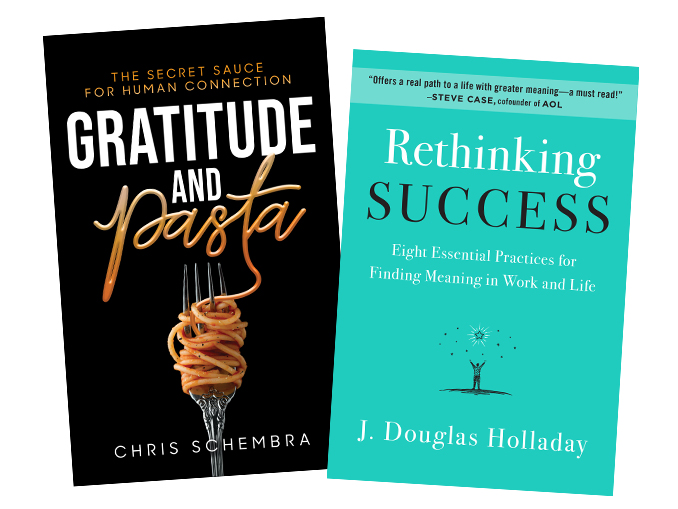Gratitude and Pasta: The Secret Sauce for Human Connection by Chris Schembra, 747 Club, 2019
Rethinking Success: Eight Essential Practices for Finding Meaning in Work and Life by J. Douglas Holladay, Harper One, 2020
In our 24/7, always on, cell phone always-within-reach world, loneliness is an epidemic.
A 2018 Cigna Insurance study on loneliness, fielded among more than 20,000 Americans, found that almost half of all Americans sometimes or always feel alone; 43 percent feel isolated from others; and half feel that they do not have meaningful in-person social interactions, such as having an extended conversation, or spending quality time with someone on a daily basis.
Chris Schembra’s Gratitude and Pasta: The Secret Sauce for Human Connection, and J. Douglas Holladay’s Rethinking Success: Eight Essential Practices for Finding Meaning in Work and Life share the same jumping-off point—that loneliness is not something that only mere mortals suffer. In fact, entrepreneurs and CEOs, who appear to have it all in terms of accomplishments and financial success, can feel the most isolated and alone. As Schembra notes, they “are twice as likely to suffer from depression, almost twice as likely to struggle with addiction, and are six times more likely to have ADHD.”
Both books mine the authors’ personal interaction with entrepreneurs and other top-level executives as a platform to describe how to overcome loneliness by creating deep connections with others and incorporating gratitude in one’s life. They both emphasize introspection and have signature questions that they ask, with Schembra’s being, “If you could give credit or thanks to one person in your life that you don’t give enough credit or thanks to, who would that be?” Two of Holladay’s are: “What are the illusions you had about life?” and “What are the mysteries you are still trying to figure out?”
Although both are interesting, easy-to-read, and helpful books, the authors’ work/business experience, backstories, and formats follow very different paths.
Holladay has an impressive CV. He worked in the White House, cofounded an equity firm, worked at Goldman Sachs, and as a Georgetown adjunct professor. He points out, “Researchers find that people have meaningful lives when three conditions are met: first, their lives make sense; second, their lives are driven by purpose; and third, they are part of something much bigger than themselves.” I would add a fourth condition, one that is implicit in the three above: maintain rich human connections. Holladay provides an effective roadmap on how to achieve this by using stand-alone chapters for each of the eight practices that he feels are needed to break out of the shell of loneliness. Within each chapter he references multiple research studies and provides mini-case studies and stories. He also does a lot of name dropping.
Unlike Holladay, who writes from the role of a reporter/observer, Schembra himself experienced the loneliness, the self-destruction, the eureka moment, and a personal exploration of figuring out what needs to be done to lead oneself out of the abyss of loneliness. He is decades younger than Holladay, has a very different CV, and shares his fascinating backstory that includes years as a theater producer, an addictive personality that led him to Alcoholics Anonymous, forays into BDSM & Kink Culture, and a foodie who draws on his Southern hospitality roots, as well as his Italian heritage and time living in Italy.
Building on his life experiences, Schembra believes we need to put the human back into how we connect with others. What could be more human than a casual, very informal pasta dinner? Schembra’s dinners are the antithesis of traditional networking events, and the book clearly shows why. Everyone (usually limited to eighteen guests sitting on folding chairs at a small table to encourage intimacy) has a role, e.g., setting the table (with disposable goods), making the pasta, opening the wine, or serving the food. Schembra has produced close to 300 of these pasta dinners for entrepreneurs, start-ups, and many well-known corporate groups, and notes that these dinners make people cry (in a good way). He feels a dinner is a “failure if less than six people cry.”
Schembra tightly choreographs these dinners as if they were theater productions. While the book provides a step-by-step approach to creating your own pasta dinners, it also provides straightforward and helpful suggestions that one can implement to feel less lonely and more engaged with others, even if one never hosts or participates in a pasta dinner.


Be the first to comment